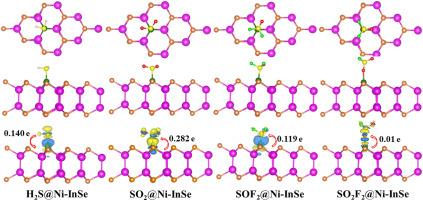SF6分解物在ni掺杂InSe单层上吸附的DFT研究:对气敏性能的见解
IF 3
4区 生物学
Q2 BIOCHEMICAL RESEARCH METHODS
引用次数: 0
摘要
本研究采用第一性原理计算研究了ni掺杂硒化铟(InSe)单层对四种SF6分解产物H2S、SO2、SOF2和SO2F2的气敏行为。结构优化、AIMD和振动分析证实了Ni-InSe单层的热稳定性。吸附结果表明:对H2S和SO2有强化学吸附,对SOF2有弱化学吸附,对SO2F2有物理吸附。值得注意的是,SOF2和SO2F2在室温下表现出高的传感响应(−99.5%和−80.1%)和快速的恢复时间(6.61 × 10−3 s和2.84 × 10−5 s),表明了良好的可重复使用性和选择性。虽然H2S和SO2在环境温度下的恢复时间较长,但在高温下检测它们是有效的。这些发现突出了Ni-InSe单层作为一种稳定、敏感和选择性的气体传感器的潜力,用于监测气体绝缘开关设备(GIS)系统中的有害SF6副产物。本文章由计算机程序翻译,如有差异,请以英文原文为准。

DFT study of SF6 decomposition species adsorption on Ni-doped InSe Monolayer: Insights into gas sensing performance
This study employs first-principles calculations to investigate the gas sensing behavior of a Ni-doped indium selenide (InSe) monolayer toward four SF6 decomposition products: H2S, SO2, SOF2, and SO2F2. Structural optimization, AIMD, and vibrational analyses confirm the thermal stability of the Ni-InSe monolayer. Adsorption results indicate strong chemisorption for H2S and SO2, weak chemisorption for SOF2, and physisorption for SO2F2. Notably, SOF2 and SO2F2 exhibit high sensing responses (−99.5 % and −80.1 %) and rapid recovery times (6.61 × 10−3 s and 2.84 × 10−5 s) at room temperature, suggesting excellent reusability and selectivity. Although H2S and SO2 have longer recovery times at ambient temperature, their detection becomes effective at elevated temperatures. These findings highlight the potential of Ni-InSe monolayer as a stable, sensitive, and selective gas sensor for monitoring hazardous SF6 byproducts in gas-insulated switchgear (GIS) systems.
求助全文
通过发布文献求助,成功后即可免费获取论文全文。
去求助
来源期刊

Journal of molecular graphics & modelling
生物-计算机:跨学科应用
CiteScore
5.50
自引率
6.90%
发文量
216
审稿时长
35 days
期刊介绍:
The Journal of Molecular Graphics and Modelling is devoted to the publication of papers on the uses of computers in theoretical investigations of molecular structure, function, interaction, and design. The scope of the journal includes all aspects of molecular modeling and computational chemistry, including, for instance, the study of molecular shape and properties, molecular simulations, protein and polymer engineering, drug design, materials design, structure-activity and structure-property relationships, database mining, and compound library design.
As a primary research journal, JMGM seeks to bring new knowledge to the attention of our readers. As such, submissions to the journal need to not only report results, but must draw conclusions and explore implications of the work presented. Authors are strongly encouraged to bear this in mind when preparing manuscripts. Routine applications of standard modelling approaches, providing only very limited new scientific insight, will not meet our criteria for publication. Reproducibility of reported calculations is an important issue. Wherever possible, we urge authors to enhance their papers with Supplementary Data, for example, in QSAR studies machine-readable versions of molecular datasets or in the development of new force-field parameters versions of the topology and force field parameter files. Routine applications of existing methods that do not lead to genuinely new insight will not be considered.
 求助内容:
求助内容: 应助结果提醒方式:
应助结果提醒方式:


